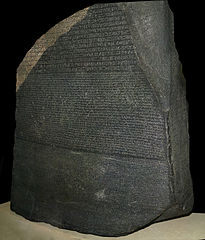
Rosetta Stone
British Museum opened in 1759. The original museum was based on the 37,000-piece collection of Sir Hans Sloane, a scientist and physician. The museum grew quickly as Great Britain entered its colonial period. Today the museum’s collection exceeds eight million objects, and over six million visitors enter its doors each year. Some of its acquisitions, for example the Rosetta Stone, have caused controversy. Children can visit the museum website at: British Museum.

